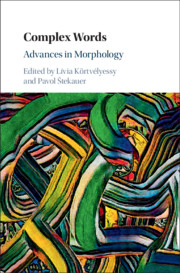Book contents
- Complex Words
- Complex Words
- Copyright page
- Dedication
- Contents
- Contributors
- Introduction: Advances in Morphology
- Part I Lexico-Semantic Aspects of Complex Words
- Part II Structure of Complex Words
- Part III Corpus-Based Case Studies
- 13 Competition between Synthetic NN Compounds and NN.gen Phrasal Nouns in Polish
- 14 An S Is an ’S, or Is It? Plural and Genitive Plural Are Not Homophonous
- 15 The Role of Word-Formation Families and Subfamilies in the Organization of German Diminutive Compounds
- 16 Semantic Patterns in Noun-to-Verb Conversion in English
- 17 Onomatopoeia
- 18 Dingsbums and Thingy
- Index
- References
16 - Semantic Patterns in Noun-to-Verb Conversion in English
from Part III - Corpus-Based Case Studies
Published online by Cambridge University Press: 18 September 2020
- Complex Words
- Complex Words
- Copyright page
- Dedication
- Contents
- Contributors
- Introduction: Advances in Morphology
- Part I Lexico-Semantic Aspects of Complex Words
- Part II Structure of Complex Words
- Part III Corpus-Based Case Studies
- 13 Competition between Synthetic NN Compounds and NN.gen Phrasal Nouns in Polish
- 14 An S Is an ’S, or Is It? Plural and Genitive Plural Are Not Homophonous
- 15 The Role of Word-Formation Families and Subfamilies in the Organization of German Diminutive Compounds
- 16 Semantic Patterns in Noun-to-Verb Conversion in English
- 17 Onomatopoeia
- 18 Dingsbums and Thingy
- Index
- References
Summary
The paper researches all the occurrences of a stratified sample of lemmas tagged both as noun and as verb in the British National Corpus, plus a set of parallel samples of denominal verbs derived by affixation intended for comparison. This design records the distribution of semantic categories not according to the lemmas in the sample, but according to how much and where they are actualized in each occurrence of the lemma (i.e. it separates the various senses within the lemmas). The sample starts out from the lowest frequency of occurrence (1). In the case of conversion, the sample spans from frequency 1 to frequency 960. Semantic categories are recorded according to the analysis of the concordances available under each of the lemmas recorded in the sample, and based on the terms of the definitions available in the Oxford English Dictionary for each sense of each lemma. The results show that the patterns described for noun-to-verb conversion have a rather dissimilar relevance with respect to each other. The distribution of semantic categories according to their occurrences in the senses attested by each of the occurrences reported for the lemmas of the corpus sample in conversion and in affixation is quite uneven.
Keywords
Information
- Type
- Chapter
- Information
- Complex WordsAdvances in Morphology, pp. 311 - 334Publisher: Cambridge University PressPrint publication year: 2020
